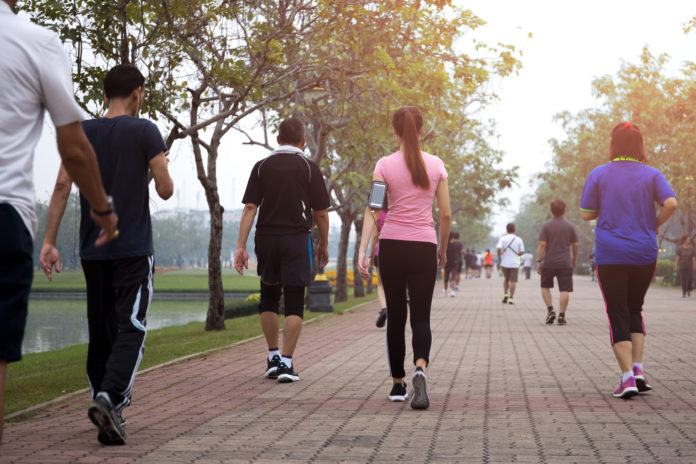Staying active and working out is not always stressful. Walking is the most simplest way to work out, and you can do it anywhere at any time. Like running and jogging, walking helps the heart stay healthy, lowers blood pressure, and strengthens bones. It also eases stress to help you sleep better.
Benefits of Walking
While we consider running and jogging to be the necessary forms of physical activity, we must not undermine the potential of walking. There are various benefits to walking, such as:
- Maintains a healthy weight
- Manages various heart-related risk factors
- Improves blood sugar control
- Improves energy levels
- Improves immunity
- Improves mood
- Strengthens bones and muscles
- Improves balance
- Improves longevity
You reap the maximum benefits of walking when you walk at a brisk pace.
Planning the Routine
It is best to plan a few things while deciding to walk:
- Appropriate gear: To enjoy your walk, choose shoes with good arch support, thick flexible soles, and a firm heel. These would not only cushion your feet but also absorb shock. In addition to this, it is good to wear comfortable clothes based on the weather.
- Choose the right course: Walking outdoors is always better to reap the fresh air benefits, but choose paths that do not have cracked sidewalks and potholes to stay safe. Also, be watchful for favorable weather when you walk outdoors.
- Warm-up: A warm-up helps to loosen up the muscles; therefore, before you take up a brisk pace, start slow walking for five to ten minutes to warm up your body.
- Cool down: Slow down your pace for five to ten minutes to cool yourself as you finish.
Setting Measurable Goals
To gain the maximum benefits of walking, set realistic goals. Walking for about 150 minutes every week is recommended. You could also include strength training exercises to increase the benefits and concentrate on a group of muscles a couple of times a week.
It is ideal to set around thirty minutes for walking, but if you cannot set apart that much time, you could attain that goal in various short sessions throughout the day. Any amount of physical activity is better than none at all. To obtain increased benefits of walking and physical activity, slowly increase it to an hour a day.
Tracking Your Progress
It is better to keep a record of how many steps you walk and the distance you covered. The joy in achieving small fitness goals will inspire you to do more. It is recommended to maintain a journal for walking. You can note down your progress and be motivated to start every day.
Staying Motivated to Walk
Walking takes both initiative and commitment. To stay motivated, you could do the following:
- Set yourself up for success: Set small goals throughout the day, such as a ten-minute brisk walk, and log it into your walk journal. Also, try to find specific times during the week, and you would soon realize that you have attained the goals that once seemed impossible.
- Make your walk enjoyable: If you do not enjoy walking alone, you could ask a friend or spouse to be your partner in walking. A group or a health club also is a good option to walk with a group. If you do not find anyone, you can listen to music as you walk.
- Change the routine: If you have decided to walk outdoors, choose different routes for walking. If you walk indoors, find different time slots and locations to walk indoors. Changing the routine makes the walk interesting.
- Do not judge missed days: If you miss some days, do not stop walking completely, understand the setbacks, and go for a walk the next day. Also, remind yourself of the benefits of walking and physical activity, most importantly, the joy and satisfaction it gives you, and maintain the routine as much as possible.
Conclusion
Walking is a great way to improve your health. It is low impact and does not need any equipment or gear. You can choose to walk any time of the day at your pace. Therefore, despite the simplicity, it is more potent and has many more benefits than we think.
Frequently Asked Questions (FAQs)
Can I walk even though I have a health condition?
For many health conditions, walking is considered the best exercise. These conditions include diabetes, cholesterol, and some heart diseases. For certain conditions, such as hip, knee, and back pain problems, it is always advisable to consult your doctor before deciding on your walking regimen.
What is the best time of the day to walk?
While this varies from person to person, walking early in the morning is the best time of the day to walk. You enjoy the maximum benefits of walking early in the morning outdoors such as fresh air, burning fat as you will be on an empty stomach, and excellent physical activity at the start of the day. But if you are busy in the mornings, you can pick any time of the day to walk. You can split your walking time of thirty minutes throughout the day and take breaks in between.
Should walking be done on an empty stomach?
Walking is both age and health dependent. You can have something small and light before you head out for walking in the morning. If you intend to burn calories, it is advisable to walk on an empty stomach and to keep yourself hydrated at all times.


















